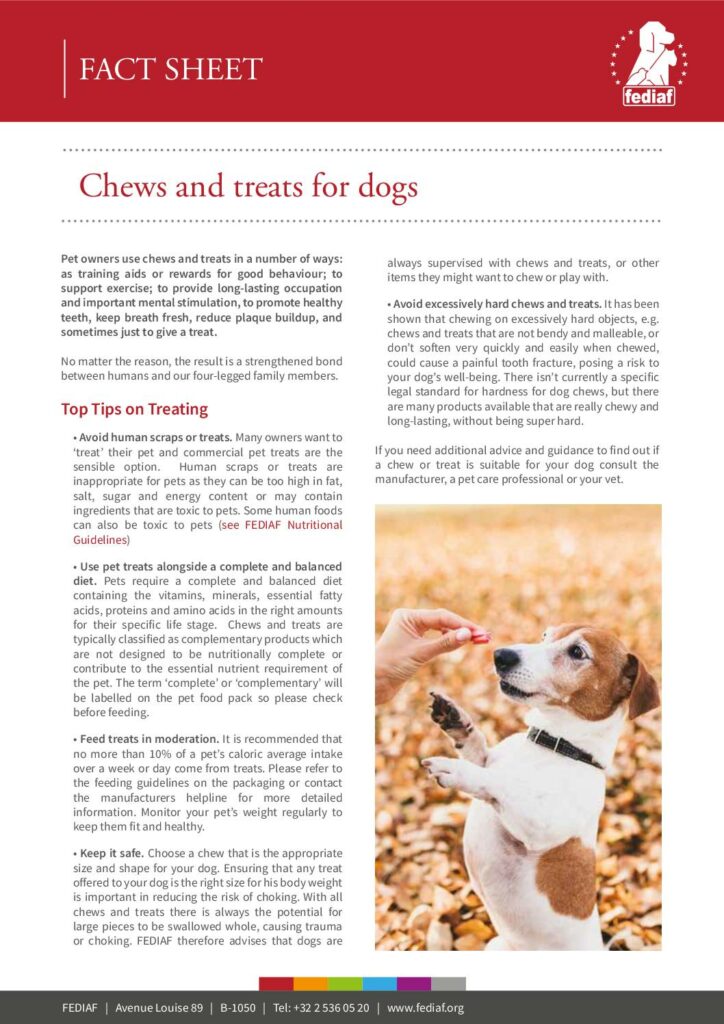Pet owners use chews and treats in a number of ways: as training aids or rewards for good behaviour; to support exercise; to provide long-lasting occupation and important mental stimulation, to promote healthy teeth, keep breath fresh, reduce plaque buildup, and sometimes just to give a treat.
No matter the reason, the result is a strengthened bond between humans and our four-legged family members.
Top Tips on Treating
- Avoid human scraps or treats. Many owners want to ‘treat’ their pet and commercial pet treats are the sensible option. Human scraps or treats are inappropriate for pets as they can be too high in fat, salt, sugar and energy content or may contain ingredients that are toxic to pets. Some human foods can also be toxic to pets (see FEDIAF Nutritional Guidelines)
- Use pet treats alongside a complete and balanced diet. Pets require a complete and balanced diet containing the vitamins, minerals, essential fatty acids, proteins and amino acids in the right amounts for their specific life stage. Chews and treats are typically classified as complementary products which are not designed to be nutritionally complete or contribute to the essential nutrient requirement of the pet. The term ‘complete’ or ‘complementary’ will be labelled on the pet food pack so please check before feeding.
- Feed treats in moderation. It is recommended that no more than 10% of a pet’s caloric average intake over a week or day come from treats. Please refer to the feeding guidelines on the packaging or contact the manufacturers helpline for more detailed information. Monitor your pet’s weight regularly to keep them fit and healthy.
- Keep it safe. Choose a chew that is the appropriate size and shape for your dog. Ensuring that any treat offered to your dog is the right size for his body weight is important in reducing the risk of choking. With all chews and treats there is always the potential for large pieces to be swallowed whole, causing trauma or choking. FEDIAF therefore advises that dogs are always supervised with chews and treats, or other items they might want to chew or play with.
- Avoid excessively hard chews and treats. It has been shown that chewing on excessively hard objects, e.g. chews and treats that are not bendy and malleable, or don’t soften very quickly and easily when chewed, could cause a painful tooth fracture, posing a risk to your dog’s well-being. There isn’t currently a specific legal standard for hardness for dog chews, but there are many products available that are really chewy and long-lasting, without being super hard.
If you need additional advice and guidance to find out if a chew or treat is suitable for your dog consult the manufacturer, a pet care professional or your vet.
Further Readings and Scientific Studies
A 2018 study published in Frontiers in Veterinary Science demonstrated the risk of tooth fractures with chews or toys that are too hard. The full study can be accessed here: Fracture Limits of Maxillary Fourth Premolar Teeth in Domestic Dogs Under Applied Forces
A 2005 study published in Yamaguchi Journal of Veterinary Medicine (Japan) showed that half of owners of dogs with fractured teeth do not notice the tooth fractures in their dogs and highlighted the importance of owner education about living environment and regular veterinary check-ups. Study abstract can be found here: A survey of the fractured teeth of sixty canines and their treatment
In a 2019 study they assessed 349 clinical cases in which foreign bodies (objects) were removed from dogs’ oesophagus (the tube that connects the mouth to the stomach). The results showed that the majority (77%) of foreign bodies causing the obstruction/injury in those cases were bones. Read more here: Complications following removal of oesophageal foreign bodies: a retrospective review of 349 cases.
A 2017 retrospective study of 222 deaths in dogs, which were treated for esophageal foreign body obstruction, showed that osseous (bone material) were the foreign body in 81% of the cases. Read more here: Risk Factors for Death in Dogs Treated for Esophageal Foreign Body Obstruction: A Retrospective Cohort Study of 222 Cases (1998-2017).
